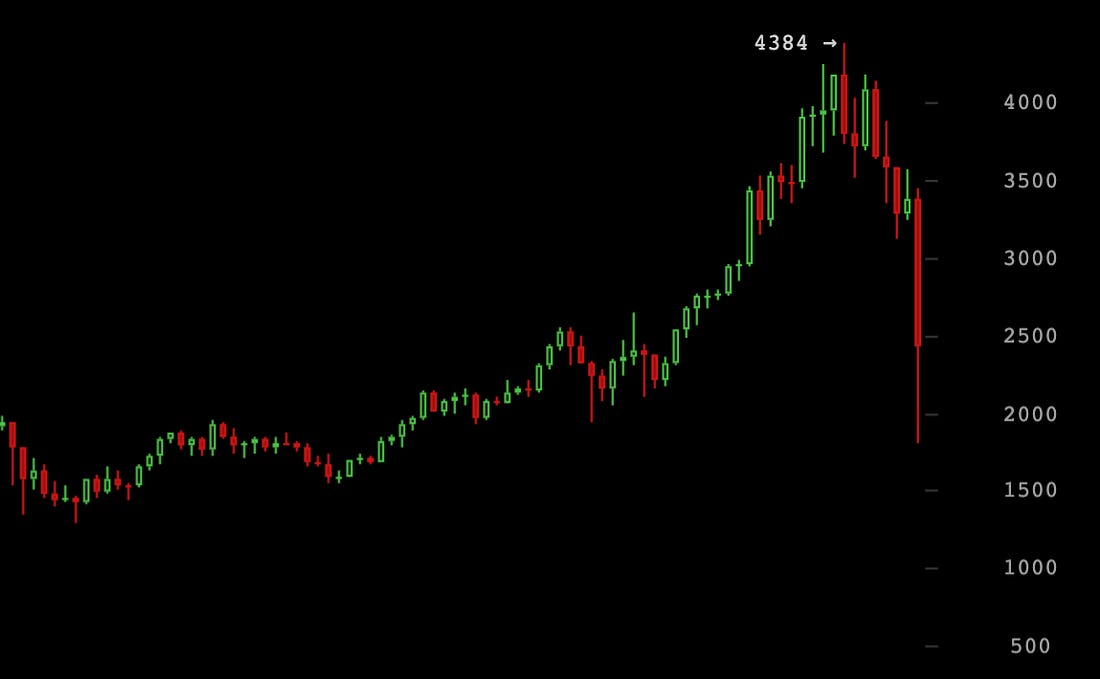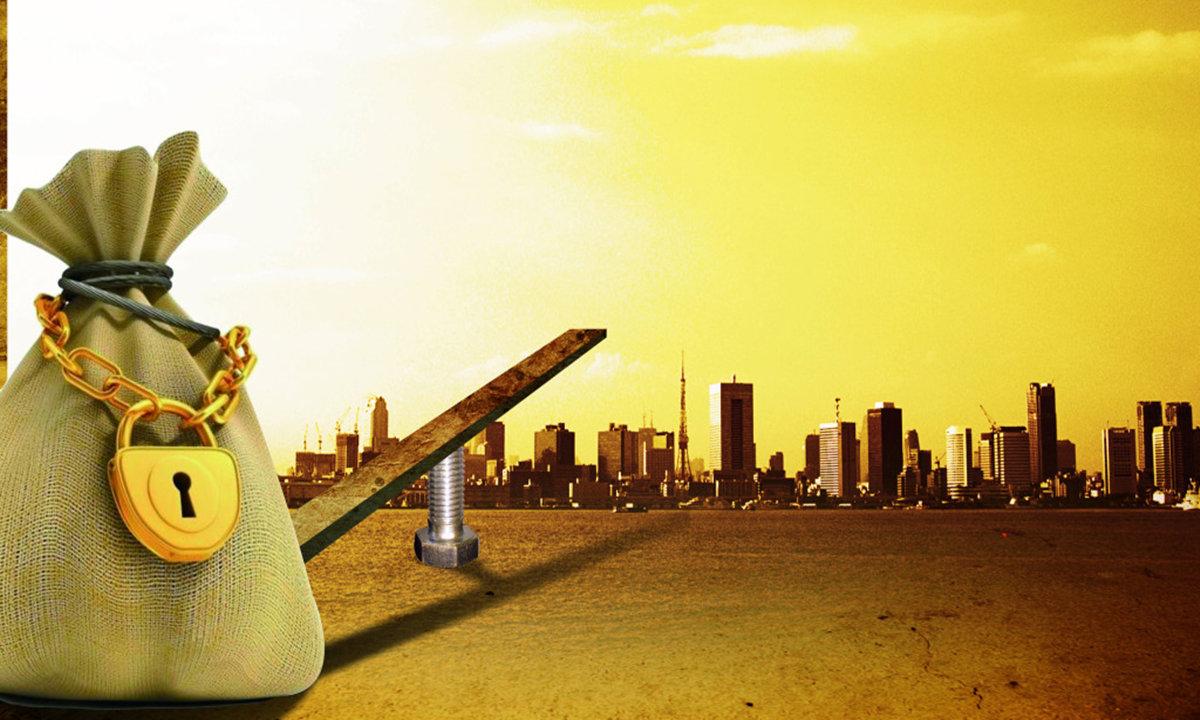Cobie: Taking the 519 incident as an example, let's discuss how to make trading judgments using probabilistic thinking
Author: Cobie, a well-known Twitter KOL
Original Title: 《Tokens in the attention economys》
Compiled by: Hu Tao, Chain Catcher
New entrants to the crypto community look to crypto "veterans" for nearly certain directional insights into these confusing markets.
Therefore, in this article, I will show you how to think about the future.
Looking Ahead
Successful crypto veterans know that crypto trading is a probabilistic outcome event. Probabilistic thinking is essentially just trying to estimate the likelihood of a specific future outcome becoming a reality.
As far as I know, it is impossible to see the future at this moment. Traders must first envision every possible future to predict the future.
Oh, none of this is investment advice. I am not a professional; I mainly stumble through this world like I did when I was 13. Just recording and sharing some thoughts, none of which are scientific. I am just an elderly baby stumbling into the forest with my eyes closed, startled by my own humanity.
Anyway, to illustrate with reality rather than Marvel movie references, let's go back to the past. This is what the ETHUSD chart looked like at the daily close on May 19.
During the market crash in May, Ethereum took 8 days to drop from around $4400 to below $1800.
During the crash, you could consider four possible scenarios for the future. When we broke below $2000, I mentioned them on Twitter.
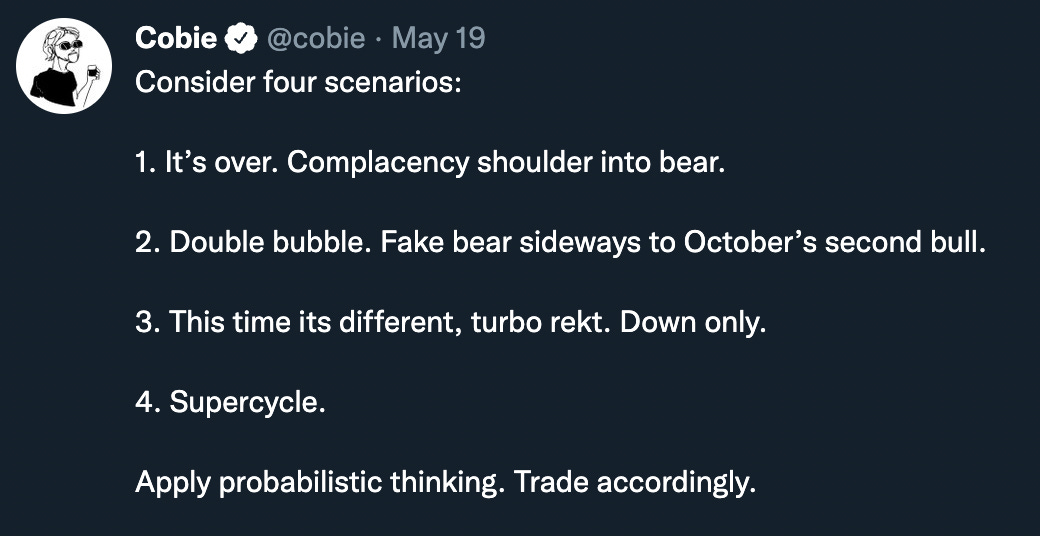
If it helps, I have drawn some embarrassingly rough candlestick versions to illustrate what the future chart might look like in each scenario.
1. The market experiences another 2017-style boom/bust cycle, and the top has already arrived.
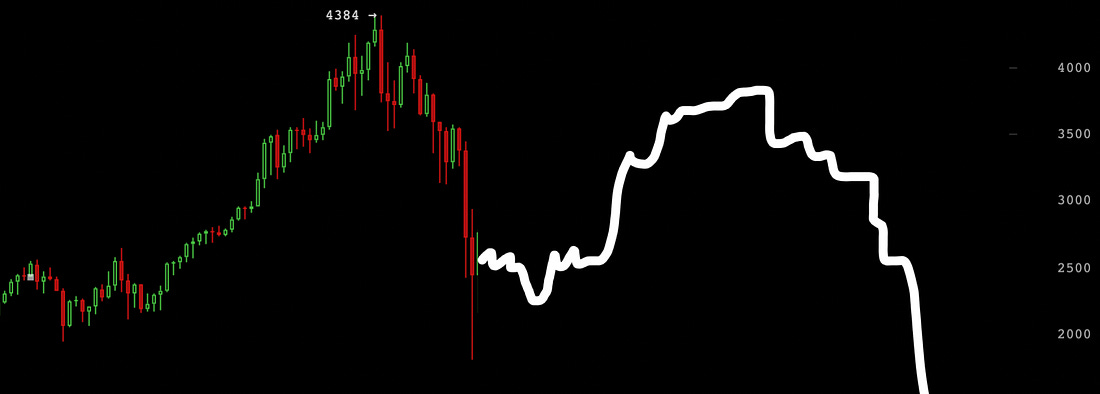
2. The market cools off before experiencing a 2013-style double bubble, and turns bullish again by the end of the year.

3. The market only goes down and experiences an almost unprecedented rebound.

4. The market will recover immediately and quickly soar to new highs.
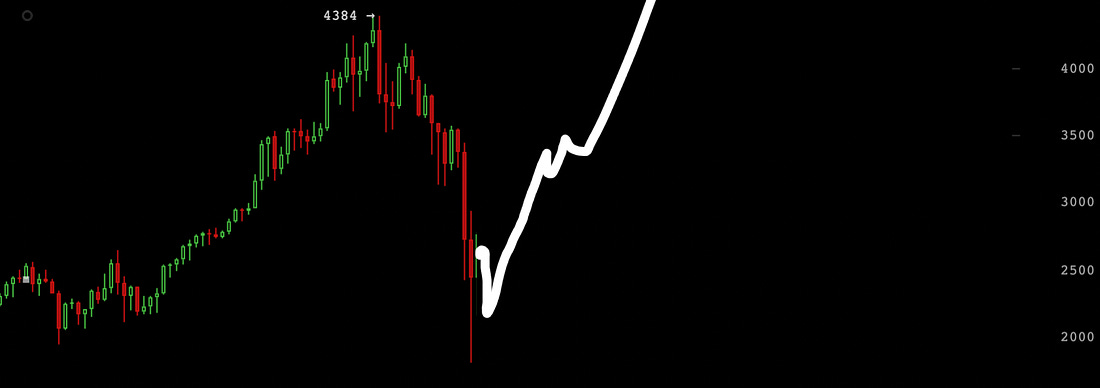
Of course, each of the above ideas has subtle variations, as well as other potential scenarios I haven't considered because I think they are too unlikely (like forever sideways).
After considering everything that could happen, excellent traders will assess the likelihood they believe each scenario will occur. At the bottom of the crash, their weights might look like this:
p(1) = 45%
p(2) = 45%
p(3) = 5%
p(4) = 5%
In reality, you think the probabilities of scenarios 1 and 2 are the same, both at 45%, and they are also the two most likely outcomes, but you are also considering that 3 and 4 are possible as well.
If you evaluate the best trades for each of the above scenarios, they are very simple:
1 ---Buy: Buy the dip and sell at the classic triangle pattern peak
2 ---Buy: Buy the dip and hold until a new high
3 ---Sell: Actually zero
4 ---Buy: Make a new high at the close
Based on these estimates, buying is the best trade in 95% of cases. There is an estimated 50% chance of a new high, a 45% chance of selling slightly below the previous all-time high, and a 5% chance of becoming completely rugged.
Specifically:
45% chance of +80% profit/loss (buying at $2000 and selling at $3600)
50% chance of over +100% profit/loss (buying at $2000 and selling at a new high)
-20% loss with a 5% chance (buying at $2000, market drops to a new low, reducing losses at $1600)
Now trading seems simple: buy at $2000, reassess around $3600, and stick to an exit plan in case the market drops to a new low. 95% of scenarios will yield at least +80%. In 5% of cases, you will lose -20%. This seems worth the risk.
If traders are already holding but haven't exited, whether before the crash or early in the crash, they can still use this information and estimates to decide to hold rather than panic sell at the low with Alameda's bid.
Doge & Musk
I talked about this in my previous blog post, but I think it is also important here.
Musk tweeted a lot about Doge in 2019 and 2020. During this bull market, he started to promote Doge again when it was below $0.01. I actually don't remember the details well, and I certainly don't care enough about this blog post to do research. Let's agree that its price was $0.01. The chart is as follows:
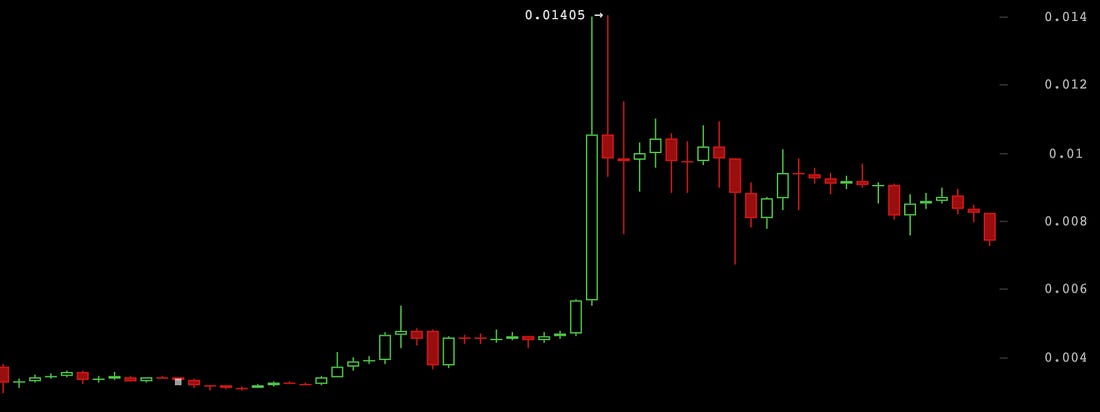
Future scenarios might look like this:
He continuously promotes it, and then it goes up.
He keeps promoting it, but it doesn't go up.
He stops promoting it, but it continues to rise anyway.
He stops promoting it, and it goes down.
Where:
p(1) = 75%
p(2) = 10%
p(3) = 7.5%
p(4) = 7.5%
Since Musk has been pushing it throughout 2019 and 2020, you could say he is likely to lean towards the market looking better and effectively driving excitement for Doge.
Of course, he might continue to promote it but be inefficient in doing so. And he might be controlled by compliance teams or certain advisors, rather than tweeting like he did in 2019 and 2020.
In the case of it going up (p(1+3)=82.5%), a trivial but conservative estimate has a 350% upside (which would put Doge at 3 or 4 cents). In the case of it not going up (p(2+4)=17.5%), there is a possibility of selling at some point between the current price and failing to maintain the previous sideways price floor—potentially dropping 50% at worst.
Based on these estimates, this bet has an 82.5% chance of yielding 3-4 times the stake, while the chance of losing 50% of the stake is moderate to small. Again, it seems worth the risk.
How do you estimate the probability of a scenario? Or does the price go up?
I have intentionally simplified this a lot; I promise not to write the cumulative distribution function of returns or anything, but I do think it is worth exploring some nuances in estimating possible futures and probabilities.
I assume the main question is: how do you propose potential scenarios and estimate their likelihood? Honestly, you are just guessing a bit. Over time, you hope to do better.
A good way to make guesses about the future is to look at what has happened in the past. This anthropological reflection on markets and assets can hint at what might happen in the future, as the past was created by a group of people who may be as smart, foolish, emotional, irrational, etc., as those present now.
You can ask some simple historical questions, such as:
Are there more than 50% retracements that did not signal the end of a bull market? If so, what was the largest mid-cycle retracement in previous cycles?
What happened after a past -30% retracement? Is there a different reason this time?
Historically, how has Doge performed against Bitcoin in bull markets? What are some conservative upper targets for the DOGE/BTC pair?
How did altcoins that were highly promoted and hyped in the past grow? What did their charts look like? Are there charts that resemble the current hype?
How many times did Bitcoin increase from the last all-time high (2013) to the next (2017)? Is this multiple reasonable for assets with market caps similar to Bitcoin's in 2017?
What typically happens when an asset is added to major exchanges like Coinbase, Binance, etc.?
History certainly does not repeat itself. But Twain might tell you that matching patterns with historical data from direct or related markets can help inform future estimation models: where prices might go and how likely that is to happen.
Experienced traders know more about the market, so rather than answering the above simple questions, they are more likely to pose more complex questions about the past and include multiple market indicators in those questions. They will consider open interest, order flow, volume profiles, entropy, or whatever they think is reliable or informative. But even as historical comparisons become increasingly complex, the overall idea and approach remain the same.
95% of people should not try
Retail traders are often not good at assessing the attributes of crypto assets because they are unfamiliar with the merits of technical or fundamental analysis—but they are also not good at assessing the price behavior of crypto assets because they are not familiar with trading concepts, price charts, and financial markets. If traders make poor or biased estimates about what might happen in the future, they are calculating poor probabilities and may lose all their money.
In fact, I think 95% of the people reading this should probably not actively trade in the crypto market. Just being exposed to the fastest-growing asset class over the past decade is enough; the potential benefits of winning some trades are not worth the risk of losing that exposure. If crypto indeed fulfills its social mission, there is still tremendous long-term upside, and rather than trying to maximize short-term gains, it is better to survive.
But I know many of you are absolute degenerates, so I will be realistic about my demands. Instead, I will just take this moment to encourage you to take a little risk. Slow things down a bit. Roll out your "get rich quick" time frame. Start recording some probabilistic thinking in your trades or investments, and then reflect on why you lost without blaming market manipulators or Three Arrows Capital. Although it might be suzhu's fault, so I sympathize.
Anyway, this is not investment advice; it is just some ways I and others have discussed thinking about short-term/mid-term price behavior to try to remain rational. But SBF said ALL IN, and he is a billionaire, so I am reconsidering things.

Other articles by Cobie:
《How to Optimize Crypto Investment Strategies Using Sub-Strategies?》
《How to Make Investment Decisions Based on FDV and Token Unlock Events?》
《Why is Attention the Only Scarce Resource in the Crypto Industry, as Exemplified by SOS, DOGE, etc.?》



